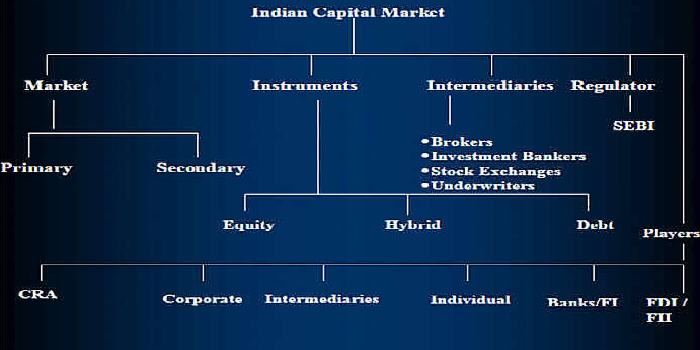In this article, we will discuss the role of the Capital Market in India. A good capital market is necessary for the industrial and commercial development of a country. The development of a good capital market is reliable upon the availability of savings, proper organisation of its constituent units, and its people’s entrepreneurship qualities.
What is a Capital Market?
A capital market is a market for medium and long-term funds. Such funds are arranged in the capital market, which are procured for a duration of 1 year. In Capital Market, buying and selling financial securities like shares, debentures, bonds, etc.
The capital market is an organised mechanism for the effective transfer of financial resources from the investing parties to the entrepreneurs engaged in the business, whether in the private sector or public sectors of an economy.
Types of Capital Market
There are two types of Capital Markets:

1. Primary Market
The primary market is also known as New Issue Market, where a company brings Initial Public Offer (IPO) to get itself listed on the stock exchange for the first time. In the primary market, the rallying of funds is done through the right issue, private placement, and prospectus. The funds that are collected by the company in the IPO is used for its future growth. Primary markets also help investors invest their savings in the companies that are planning to expand their enterprises.
2. Secondary Market
In the secondary market, the securities that are already listed on the exchange are traded. The trading done on the stock exchange and over the counter falls under the secondary market category. Examples of secondary markets in India are the National Stock Exchange (NSE) and the Bombay Stock Exchange (BSE).
How are funds raised?
- Offer through Prospectus
The prospectus is used to raise funds in the capital market. The company invites the investors and the general public through an advertisement known as the prospectus to make them subscribe to the company’s shares. On the basis of subscription, shares or debentures are allotted to the public. If the company receives a high subscription, then allotment is given to them on a pro-rata basis. For the purpose of selling the shares to the public, the company hires merchant bankers, brokers, or underwriters.
- Private Placement
IPO route is costly; that’s why Some companies try to avoid the IPO route to raise funds. They give investment opportunities to a few individuals through private placement. In private placement, the companies can offer their shares for sale to select individuals, financial institutions, insurance companies, and banks. In this way, they can raise funds quickly and economically.
- Rights Issue
The structure of the capital market is designed to allow the companies in need of additional funds to first approach their current investors before looking at the other sources for finance. The right issue gives the current investors the first opportunity to make additional investments in the company. The allotment of the right shares is done on a pro-rata basis. If the company’s current shareholders do not want to use their rights, the shares can be offered to the public.
- e-IPO
e-IPO refers To Electronic Initial Public Offer. e-IPO agrees between the stock exchange and the company to offer its shares to the public through an online mode. It is a very fast process. The company is required to appoint a registrar to the issue and brokers to accept the application that is received from the public.
Structure of Capital Market in India:

Instruments of Capital Market:
There are mainly two types of instruments which are traded in the capital market, which are:
- Stocks: Stocks are bought and sold over a stock exchange, They represent ownership of the company, and the buyer of the share is referred to as the shareholder.
- Bonds: The debt securities which are traded in the capital market are known as the bonds. Companies issue bonds in order to raise the capital fee and the expansion of the business and growth.
Also read- Top 10 Best Refrigerator under 25000
Functions of the Capital Market
- It helps in the movement of capital from the people who save money to the people who want more money.
- It assists in financing long-term projects of the companies and Encourages the investors to own the range of productive assets.
- It also minimises the cost of transactions.
- It helps in the faster valuation of financial securities like debentures and shares.
- It Creates liquidity in the market by accelerating the trading of securities in the secondary market.
- It offers protection against price or market risks through the trading of derivative instruments.
- It helps in operative capital allocation by way of a competitive price mechanism.
- It helps in the creation of liquidity and regulation of funds.
Growth of Capital Market in India:
The capital market plays a very important role in the allocation of resources. These well-developed and well-functioning capital markets can cope with liquidity shocks that may cause serious havoc in the economy and prevent them from happening. Moreover, the capital market enables financial institutions and non-banking financial companies to access funds on a medium and long-term basis.
Before Independence, India’s organized component of the capital market exhibited backwardness. After Independence, India’s capital market had gained a greater degree of maturity when the government took various measures to tone up the capital market.
The deficiencies of India’s capital market before 1991 were removed because of the following factors:
- Legislative measures have been taken by the Government to protect investors’ interests from time to time. These issues include;
Companies Act, 1956
the Capital Issues (Control) Act, 1947
the Securities Contracts (Regulation) Act, 1956
All the above-mentioned Acts empowered the Government so as to regulate the activities of the capital market. The main goal of these Acts was to promote a strong and healthy investment market, protect the interests of genuine investors, and ensure efficient utilisation of financial resources.
- Soon after India’s independence, the Government felt the need to establish a number of financial institutions to take care of the financial needs of the industries.
Financial Institutions–
- Industrial Finance Corporation of India (1948)
- State Financial Corporations (1951)
- Industrial Credit and Investment Corporation of India (1955)
- Industrial Development Bank of India (1964)
- Industrial Reconstruction Bank of India (1971)
- Unit Trust of India (1964)
- Life Insurance Corporation of India (1956)
Non-banking financial companies (governed by the 1956 Companies Act)-
- Equipment Leasing Company
- Investment Company
- Loan Company
- Hire-Purchase Finance Company
- Mutual Benefit Financial Company
- Infrastructure Leasing and Financial Services
- The patronising business has grown consequentially over the years because of the actions taken by the owners of financial institutions, including commercial banks, insurance companies, and stockbrokers.
If we look at these developments (prior to 1991), the capital market base has widened. A large number of people park their savings in corporate securities. However, the Indian capital market has remained subdued for a long time since the 1960s.
Since the beginning of the 1980s, there has been a remarkable improvement in the health of the market due to various innovations like all-round revival, which was a necessity so as enable the industry to undertake the required investment and achieve the desired growth.
Capital Market in the Reform Era:
(a) Reforms in the Capital Market till 1980:
The capital market reform is an important part of the agenda of financial sector reforms. Though the capital market had been doing well till the late 1980s, we can see that the limited volume of activity of the capital market as it has displayed numerous problems.
These problems are-
1.The Information and transparency in procedures were limited.
2. The Market was highly vulnerable to price rigging and insider trading. The prevalent brokerage system of the country’s capital market obstructed access to the market for new investors. The common malpractices among the brokers are related to the price at which shares are bought and sold.
3. The danger of speculative transactions is largely associated with the stock market.
4. The trading took place by ‘open outcry’ on the trading floor monopolised by 3,000 odd brokers who closed membership to outsiders.
5. The registration of transactions being time- consuming, one often is led to manipulation. No action was taken against brokers for such malpractice.
6. The poor communications infrastructures shredded the equity market.
7. The trading took place with fortnightly settlement. This settlement is known as “futures-style settlement.” The settlement mechanism in practice resulted in such settlements beyond a fortnight.
(b) Reforms in the Capital Market and SEBI since 1991:Capital market reforms were introduced in 1992 along with the lines that were recommended by the Narasimha Rao Committee’s recommendations. The reforms wholly affected the equity market.
Challenges of the Capital Market in India:
There are certain challenges that continue to block the development of the Indian economy.The main challenges that act as a hindrance in the growth of the Indian economy are as follows-
- Inflation: The inflation rate indicates the downfall of the purchasing power of the people of the country and the growing prices of the goods and services. Inflation happens to be one of the biggest concerns of any nation as well as with India. Though there have been many monetary policies and regulatory policies released by the Reserve Bank of India, inflation is still one of the biggest challenges that block the growth and development of the Indian Capital Market.
- GDP: Gross Domestic Product or GDP is another important factor in the capital market’s growth and development. GDP growth of the Indian economy is highly disappointing and highlights a downward trend. lower GDP becomes more challenging for the country. Currently, India is facing a negative GDP growth due to the pandemic spread all across the world. Due to several lockdowns in the country, the majority of people experience a huge loss.
- Foreign Policy: A country’s foreign policy deals with Foreign Direct Investments (FDI) that a country is likely to receive. The higher the rate of the FDI flows to the country, the better it is for the country in the short run as well as in the long run.
- Education and Unemployment: Unemployment is another major issue that affects the Indian capital market and its growth and development. The literacy rate, too, plays a vital role in the growth and development of the nation. Though the literacy rate is increasing, the rate of increment is low. There are many literate people, but they are unemployed.
FAQs related to Capital Market in India:
Q. What is the difference between The Capital Market and The Stock Market?
Ans. stock market is a part of the capital market. People often use them interchangeably.
Capital market is a market where people can get money to run their business, and in exchange, they offer some sought of partnership or shareholding in their company.
Q. What is the process of investing in Equity?
Ans.To invest in equities, an investor must open the following accounts.
- A broking account with an authorized stockbroker
- A demat account with a depository participant
- A bank account for cash payments and receipts.
One can also use their existing bank accounts for this purpose. Moreover, an investor must decide that whether he wants to invest by making purchases or taking delivery of shares or by undertaking margin trading wherein an investor has to only pay a portion of the purchase price while the broker funds the remaining cost of shares. Margin trading, which can magnify his buying power, doesn’t involve the delivery of shares as an investor; it only books profits or loss.
Q. What is Debenture?
Ans. A debenture is a bond issued by a company bearing a fixed rate of interest usually payable half-yearly on specific dates and principal amount repayable on a particular date on the debentures’ redemption. Debentures are normally charged against the asset of the company in favor of the debenture holder.
Q. What are the jurisdictions applicable to capital market activities?
Ans. The following jurisdictions will be applicable for capital market activities:
Indian Jurisdiction: Subject to the SEBI Act 1992, the Securities Contracts (Regulation) Act, 1956 (42 of
1956), the Depositories Act, 1996 (22 of 1996), provisions of Companies Act, 2013 administered by SEBI.
Foreign Jurisdiction: A foreign country other than India whose securities market regulator is a signatory to the International Organization of Securities Commission’s Multilateral MoU (IOSCO’s MMOU) or a signatory to
bilateral MoU with SEBI and not blacklisted by the Financial Action Task Force.
